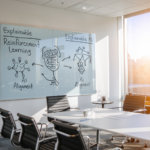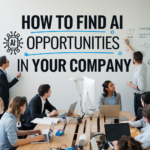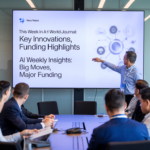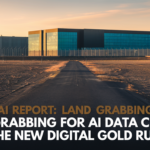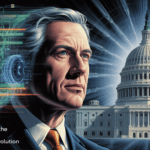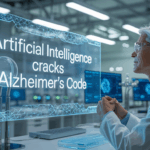AI’s Double-Edged Sword: Driving and Hindering Automation Growth
As artificial intelligence (AI) and automation continue to advance, a paradoxical question arises: could AI itself, rather than accelerating automation, actually slow it down? This may seem contradictory, given AI’s role in driving automation across numerous industries. However, several factors suggest that AI could indeed decelerate automation in certain areas or reshape its path. Recent reports on automation trends highlight these dynamics, revealing complex interactions between AI, automation, and broader societal factors.
Ethical and Regulatory Concerns: Striking a Balance
One of the most significant barriers to automation growth comes from the ethical and regulatory frameworks being developed around AI. As AI systems become more sophisticated and embedded into high-stakes industries such as healthcare, finance, and autonomous vehicles, ethical concerns about bias, decision-making, and accountability emerge. This has led to heightened scrutiny from governments, regulators, and advocacy groups.
The latest reports from the World Economic Forum and AI Now Institute highlight that many industries are delaying full automation due to regulatory uncertainty. For instance, in the transportation sector, self-driving cars face significant regulatory roadblocks, even though the technology is advancing rapidly. Governments are struggling to create frameworks that allow for the safe and equitable deployment of AI-driven automation. Ethical concerns, such as who is accountable in the event of an autonomous vehicle crash, have delayed approvals and mass adoption.
Similarly, in healthcare, automation in diagnostics and treatment is technically possible but faces regulatory pushback. The fear of misdiagnoses, biased AI models, and data privacy violations requires strict regulatory oversight, slowing down the full automation of these systems.
Job Market Pressures: The Human Factor
One of the most cited reasons for delaying automation is its potential impact on employment. AI has the potential to displace large segments of the workforce, particularly in industries like manufacturing, logistics, retail, and customer service. This fear has led to calls for policies that protect jobs and promote “human-in-the-loop” systems—AI applications that support rather than replace human workers.
A recent McKinsey report estimates that while AI could automate 25% of current jobs by 2030, political and social pressure is likely to slow down the pace of this transition. The growing conversation around “responsible AI” encourages the development of systems that collaborate with human workers, allowing for smoother transitions and mitigating the risks of mass unemployment.
For example, in logistics, rather than fully automating warehouses, companies like Amazon are increasingly adopting AI tools that work alongside human workers to enhance productivity while retaining the human element for more complex tasks. This approach is more socially acceptable and helps alleviate concerns about job displacement, but it inevitably slows down the overall speed of full automation.
Complexity and Technical Challenges: AI’s Growing Pains
AI’s potential to automate more complex and nuanced decision-making processes remains a challenge. While AI excels at automating routine tasks, more sophisticated applications—such as those requiring creativity, emotional intelligence, or human judgment—are harder to achieve. Automation in sectors like law, education, and creative industries faces technical limitations. AI’s ability to interpret complex, subjective, or contextual information is still developing.
Recent research from MIT Technology Review points out that while AI has progressed rapidly in certain domains, its performance in others remains uneven, which affects its ability to drive automation growth. For instance, AI has made remarkable advances in image and speech recognition, but its capacity to automate tasks requiring deep contextual understanding, such as negotiations or nuanced decision-making, remains limited.
This is particularly evident in the financial services industry, where automation of trading and investment analysis has been successful, but fully automating areas like compliance and legal advice is still hampered by AI’s limited ability to interpret complex regulations and contextual data.
Economic Costs and Investments: Financial Hurdles to Automation
The high cost of AI-driven automation is another factor that can slow down its adoption. While large corporations may have the capital to invest in AI, small and medium-sized enterprises (SMEs) often struggle to keep up with the financial demands of AI integration. The costs of implementing AI—ranging from acquiring the technology to retraining staff—can be prohibitive for many businesses.
A recent report from Deloitte indicates that many companies are adopting AI and automation incrementally rather than fully automating all at once, largely due to economic concerns. This “phased approach” allows businesses to test AI systems and gradually integrate them, but it also means that full automation may take years to achieve. For example, many manufacturing firms are choosing to automate specific production lines while maintaining human workers in other areas until the ROI of AI-driven automation becomes clearer.
AI as an Enabler of Human-Centered Automation: Redefining Automation’s Role
Rather than pushing toward full automation, AI is increasingly being developed as a tool to enhance human capabilities. Recent trends suggest that AI may slow down full automation as companies opt for systems that enhance human productivity rather than replace human roles altogether. This shift could reshape the future of work, leading to more collaborative systems where AI assists workers rather than displacing them entirely.
Reports from Accenture emphasize the growing interest in “human-centered” AI, where the focus is on augmenting human capabilities rather than achieving total automation. This is particularly relevant in sectors like healthcare, education, and customer service, where human interaction remains a critical component. AI-driven tools that assist with decision-making, enhance data analysis, or automate routine administrative tasks are being adopted at a faster rate than fully autonomous systems.
Latest Reports on AI and Automation
The World Economic Forum’s latest 2024 Future of Jobs report highlights that while AI is accelerating change, it’s also creating new roles that demand human oversight. The report estimates that while 85 million jobs may be displaced by automation, 97 million new jobs will emerge that require skills in AI oversight, data analysis, and machine learning. The OECD (Organisation for Economic Co-operation and Development) recently published a report cautioning against the “blind pursuit” of full automation, advising industries to focus on augmenting the workforce with AI rather than replacing it.
Meanwhile, a recent PwC report notes that companies are prioritizing investments in AI-enhanced systems that work alongside humans. This trend is more pronounced in sectors that require creativity, emotional intelligence, or regulatory oversight. The report highlights industries like law, where AI is being used to support research and document analysis but full automation of legal advice remains a distant goal.
The Evolving Relationship Between AI and Automation
While AI is undoubtedly a key driver of automation, its role in holding back automation growth cannot be ignored. Ethical considerations, regulatory frameworks, job market dynamics, and economic challenges are all contributing factors that influence how quickly—and to what extent—automation is adopted across industries.
In the near future, AI may reshape automation growth by encouraging more human-centered systems that enhance productivity without fully displacing workers. Reports suggest that while full automation is still on the horizon, its pace will be tempered by society’s need to ensure responsible, ethical, and sustainable integration of AI into the workforce.
In this evolving landscape, AI’s ability to slow down or redefine automation may ultimately lead to a more balanced, thoughtful, and inclusive approach to technological progress.
